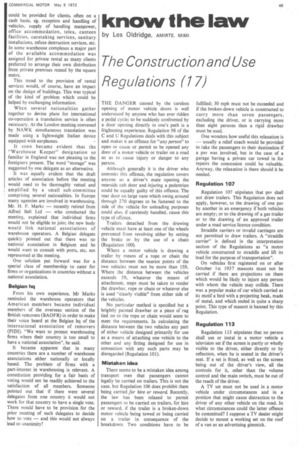know the law
Page 51

If you've noticed an error in this article please click here to report it so we can fix it.
by Les Oldridge, AMIRTE, MIMI
The Construction and Use Regulations (17)
THE DANGER caused by the careless opening of motor vehicle doors is well understood by anyone who has ever ridden a pedal cycle: to be suddenly confronted by a door opening directly in one's path is a frightening experience. Regulation 98 of the C and U Regulations deals with this subject and makes it an offence for "any person" to open or cause or permit to be opened any door of a motor vehicle or trailer on a road so as to cause injury or danger to any person.
Although generally it is the driver who commits this offence, the regulation covers anyone so a driver's mate opening the nearside cab door and injuring a pedestrian could be equally guilty of this offence. The rear door on large vans which swing around through 270 degrees to be fastened to the side of the vehicle for unloading purposes could also, if carelessly handled, cause this type of offence.
Trailers detached from the drawing vehicle must have at least one of the wheels prevented from revolving either by setting the brake or by the use of a chain (Regulation 100).
Where a motor vehicle is drawing a trailer by means of a rope or chain the distance between the nearest points of the two vehicles must not be more than 15ft. Where the distance between the vehicles exceeds 3ft, whatever the means of attachment, steps must be taken to render the drawbar, rope or chain or whatever else is used -clearly visible" from either side of
the vehicles. • No particular method is specified but a brightly painted drawbar or a piece of rag tied on to the rope or chain would seem to meet the requirements. In calculating the distance between the two vehicles any part of either vehicle designed primarily for use as a means of attaching one vehicle to the other and any fitting designed for use in connection with any such parts may be disregarded (Regulation 101).
Mistaken idea
There seems to be a mistaken idea among transport men that passengers cannot legally be carried on trailers, This is not the case. but Regulation 106 does prohibit them being carried for hire or reward. Recently, the law has been relaxed to permit passengers to be carried on trailers, for hire or reward, if the trailer is a broken-down motor vehicle being towed or being carried on a trailer in consequence of the breakdown. Two conditions have to be
fulfilled; 30 mph must not be exceeded and if the broken-down vehicle is constructed to carry more than seven passengers, excluding the driver, or is carrying more than eight persons then a rigid drawbar must be used.
One wonders how useful this relaxation is usually a relief coach would be provided to take the passengers to their destination if a psv was involved, but in the case of a garage having a private car towed in for repairs the concession could be valuable. Anyway, the relaxation is there should it be needed.
Regulation 107 Regulation 107 stipulates that psv shall not draw trailers. This Regulation does not apply, however, to the drawing of one psv by another in an emergency if both vehicles are empty; or to the drawing of a gas trailer or to the drawing of an approved trailer under a road service licence condition.
Straddle carriers or invalid carriages are not permitted to draw trailers. A "straddle carrier" is defined in the interpretation section of the Regulations as "a motor vehicle constructed to straddle and lift its load for the purpose of transportation".
On vehicles first registered on or after October 1st 1937 mascots must not be carried if there are projections on them which would be likely to injure any person with whom the vehicle may collide. There was a popular make of car which carried as its motif a bird with a projecting beak, made of metal, and which ended in quite a sharp point. This type of mascot is banned by this Regulation.
Regulation 113 Regulation 113 stipulates that no person shall use or instal in a motor vehicle a television set if the screen is partly or wholly visible to the driver, either directly or by reflection, when he is seated in the driver's seat. If a set is fitted, as well as the screen being out of the driver's view, all the controls for it, other than the volume control and the main switch, must be out of the reach of the driver.
A TV set must not be used in a motor vehicle under circumstances and in a position that might cause distraction to the driver of any other vehicle on the road. In what circumstances could the latter offence be committed? I suppose a TV dealer might decide to mount a working set on the roof of a van as an advertising gimmick.




























































































